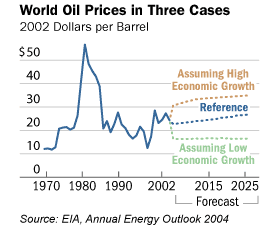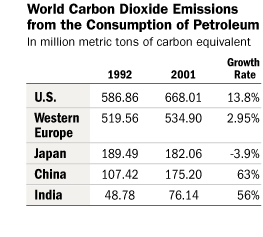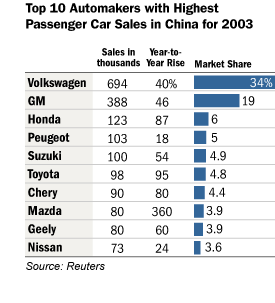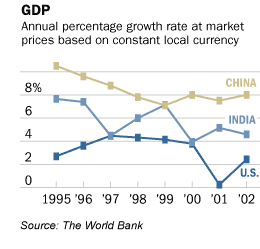Wall Street Journal, May 5, 2004.
As the global economy roars ahead with more factories churning out consumer goods and more cars hitting the streets, demand for oil may outstrip supply. World-wide use is forecast to rise more than 50% to 121 million barrels a day by 2025, from 80 million barrels a day now. In China and India, the world's most populous countries, economic growth is powered by and in turn fueling a thirst for oil.
Experts warn that without alternative fuel sources, the need for oil could pit massive consumers such as the U.S. against China and India. Gal Luft, executive director of the Institute for Analysis of Global Security, an energy-policy think tank, warns, "While the U.S. is absorbed in fighting the war on terror, the seeds of what could be the next world war are quietly germinating. ... By 2030, China is expected to have more cars than the U.S. and import as much oil as the U.S. does today." Although India's economy isn't growing as fast, its oil consumption is skyrocketing.
Both countries are paying little heed to the environmental and medical consequences of development and argue that other countries industrialized without concern for carbon emissions.
--By Kirsti McCabe
As China and India look to the same sources for oil that the U.S. has long tapped, competition for a limited supply could spark the next round of geopolitical strife. Click on the U.S. supplier countries below to learn what could jeopardize their oil exports.
 
The U.S. Department of Energy forecasts that oil prices will decline to $23.57 a barrel in 2005 from near $40 now, and rise to around $27 in 2025, thanks to new exploration and production technologies, as well as alternative sources of energy. But the Energy Department concedes that "some oil market analysts find this viewpoint overly optimistic, based on what they consider to be a significant overestimation of both proved reserves and ultimately recoverable resources."
Paul Roberts, author of the book "The End of Oil, On the Edge of a Perilous New World," said in an interview that between 2012 and 2015, there will be signs of a peak in "easy oil" -- supplies that can be produced at prices roughly equivalent with today's. After that, he says, "you'll have to be willing to spend $35 to $40 a barrel for oil. As soon as oil outside of OPEC goes beyond $45 a barrel, OPEC will also raise its prices. With China helping us eat through easy oil much faster than anticipated, we'll reach that depletion point much more quickly."
Another pessimist is Matthew Simmons, chairman and chief executive of Simmons & Co. International, an investment-banking firm that focuses on the energy industry. Mr. Simmons, who has advised the Clinton and Bush administrations on energy policy, says prices could surpass $40 a barrel if sources remain constant but demand continues to grow.

Economic growth has brought measurable benefits to China and India. People have better nutrition, and are buying homes and cars, washing machines and televisions. But cities in both countries regularly top lists of the world's most polluted areas. A World Resources Institute study ranked Beijing and Calcutta among the world's most polluted cities with extraordinarily high levels of pollutants from motor vehicles and industry.
The U.S., long the biggest producer of carbon-dioxide emissions, may soon lose that slot to China, which is projected to post the greatest absolute growth in carbon-dioxide emissions between 2003 and 2020. Unlike the U.S., India and China signed the United Nations International Treaty on Climate Change, or the Kyoto Protocol, but as developing nations, are exempt from binding reductions in emissions of greenhouse gases.
Despite piecemeal efforts to curb pollution, such as testing electric rickshaws in India, industrialization has resulted in "considerable environmental degradation" according to the Energy and Resources Institute, an Indian organization devoted to sustainable development. Mr. Roberts, author of "The End of Oil," says cost is a huge obstacle to cleaner energy: "The Chinese are saying 'We can't afford high technology to make cleaner use of energy.' They're saying, 'The developed world had its shot at rapid industrialization with little regard to the environment, we want our chance too.' "

Cars and trucks will cause almost 75% of the increase in oil consumption by India and China between 2001 and 2025, says Aloulou Fawzi, an Energy Information Administration economist.
Dr. Fawzi says "Global economic growth, the main driver of oil demand growth, is expected to be 3.1% per year. China and India are expected to achieve the highest rates of economic growth, averaging 6.2% and 5.2% respectively between 2001 and 2025. As a result, developing countries' share of world oil demand will rise from 35% in 2001 to 45% in 2025 while industrialized countries' share drops from 58% in 2001 to 47% in 2025."
India's oil demand is projected to grow by 4% annually from 2.1 million barrels a day in 2001 to 5.5 million barrels in 2025, and about 70% of the increase in oil demand will come from the transportation sector. Estimates from 2001 count 4.9 million cars and 6.9 million commercial vehicles in India, with a vehicle-ownership rate of 195 people per car, compared with one car for every 1.3 people in the U.S. Although the Indian government has introduced measures to lower carbon-dioxide emissions, notorious polluters such as diesel vehicles are still common.
China's passenger-car market is growing even faster, increasing tenfold between 1990 and 2000. China had 4.32 million registered automobiles and 10.21 million registered trucks and buses at the end of 2001, compared with 128.7 million cars and 87.96 million trucks and buses in the U.S.

Consequences aside, China and India are sustaining a blistering economic pace. China's industrial output grew 17% in 2003, 18% for the first quarter of 2004, including a 23% rise in February and a 19% burst in March. India's industrial production grew 7.4% in February and at an annual rate of 6.7% for the nine months before that. By comparison, U.S. industrial production rose for the first quarter as a whole, at an annual rate of 6.6%.
China, chilled by inflation fears, recently took steps to curb growth by ordering banks to halt new commercial loans for several days. The country's economy grew 9.7% in the first quarter of the year, and Prime Minister Wen Jibao said that China should "reduce speed" without "a very sudden slowing" to avoid overheating.
Dr. Luft of the Institute for Analysis of Global Security warns: "The oil market is too small to hold three massive consumers. The best way would be for China to circumvent complete dependency on oil. ... Without substantial American technological support, China is likely to follow the path of least resistance and become a full-fledged oil economy."
Copyright 2004 Dow Jones & Company, Inc. All Rights Reserved
|

